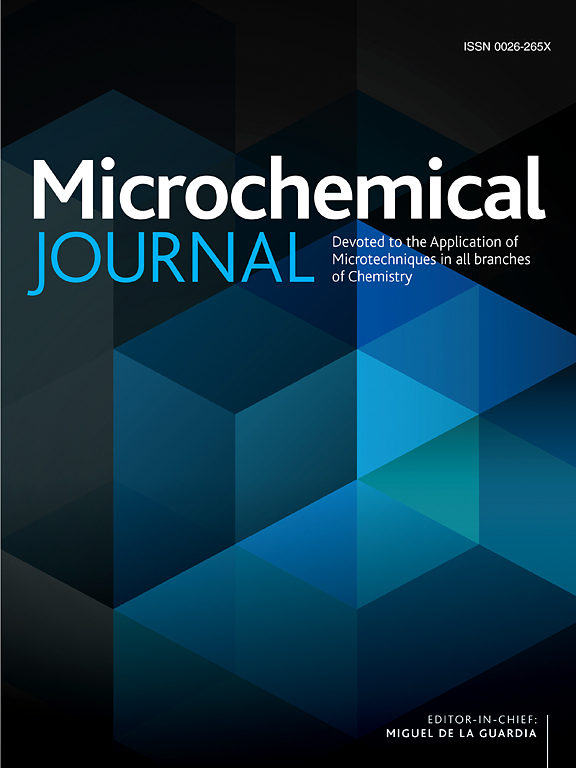基于 DNA 四面体支架的烟草样品中黄曲霉毒素 B1 的一步比率电化学检测方法
IF 4.9
2区 化学
Q1 CHEMISTRY, ANALYTICAL
引用次数: 0
摘要
为了有效监测烟草样品中的黄曲霉毒素 B1(AFB1),一种基于 DNA 四面体支架(DTS)和 AuNPs/壳聚糖(CS)修饰电极的比率电化学生物传感器被成功制成。超薄 AuNPs 不仅具有更大的比传感表面,还能在电极表面接枝更多的 DTS。DTS 与两股 AFB1 合酶直接磨合,从而实现了对 AFB1 的一步式检测。在 AFB1 存在的情况下,亚甲基蓝(MB)的电流保持稳定,而二茂铁(Fc)的电流则会下降,因为目标物会从电极表面带走 Fc 标记的适配体。制成的生物传感器可在 0.01-1000 pg-mL-1 的线性范围内监测 AFB1,检测限(LOD)为 2.6 fg-mL-1。更重要的是,该生物传感器在检测烟草样品中的 AFB1 时表现良好,检测限为 2.86 fg-mL-1。所开发的比率电化学生物传感器在烟草样品的 AFB1 检测中具有高选择性、良好的稳定性和高潜力。本文章由计算机程序翻译,如有差异,请以英文原文为准。

DNA tetrahedral scaffold based one-step ratiometric electrochemical detection of aflatoxin B1 in tobacco samples
To effectively monitor Aflatoxin B1 (AFB1) in tobacco samples, a ratiometric electrochemical biosensor based on DNA tetrahedral scaffold (DTS) and AuNPs/chitosan (CS) modified electrode has been successfully fabricated. The ultra-thin AuNPs not only present a larger specific sensing surface, but also can graft more DTS onto the surface of the electrode. The DTS is directly grated with two strands of AFB1 aptamer, which leading to a facile one-step detection of AFB1. In the presence of AFB1, the current of methylene blue (MB) keeps stable, while the current of ferrocene (Fc) decreases since the target takes away the Fc-labeled aptamer from the electrode surface. The fabricated biosensor can monitor AFB1 in the linear range of 0.01–1000 pg·mL−1 with the detection limit of (LOD) 2.6 fg·mL−1. More importantly, the biosensor performs well in the detection of AFB1 in tobacco samples with the LOD of 2.86 fg·mL−1. The developed ratiometric electrochemical biosensor displays high selectivity, good stability and high potential in tobacco sample’s AFB1 detection.
求助全文
通过发布文献求助,成功后即可免费获取论文全文。
去求助
来源期刊

Microchemical Journal
化学-分析化学
CiteScore
8.70
自引率
8.30%
发文量
1131
审稿时长
1.9 months
期刊介绍:
The Microchemical Journal is a peer reviewed journal devoted to all aspects and phases of analytical chemistry and chemical analysis. The Microchemical Journal publishes articles which are at the forefront of modern analytical chemistry and cover innovations in the techniques to the finest possible limits. This includes fundamental aspects, instrumentation, new developments, innovative and novel methods and applications including environmental and clinical field.
Traditional classical analytical methods such as spectrophotometry and titrimetry as well as established instrumentation methods such as flame and graphite furnace atomic absorption spectrometry, gas chromatography, and modified glassy or carbon electrode electrochemical methods will be considered, provided they show significant improvements and novelty compared to the established methods.
 求助内容:
求助内容: 应助结果提醒方式:
应助结果提醒方式:


